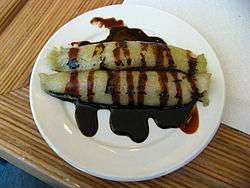Suman (food)
|
Suman sa Ibus, a variety of Suman wrapped in young palm leaves. | |
| Alternative names | Rice Cake |
|---|---|
| Place of origin | Philippines |
| Main ingredients | Glutinous rice |
|
| |
Suman is a rice cake originating from the Philippines. It is made from glutinous rice cooked in coconut milk, often wrapped in banana leaves or buli or buri palm (Corypha) leaves for steaming. It is usually eaten sprinkled with sugar or laden with latik. Suman is also known as budbod in the Visayan languages that dominate the central half of the country. A widespread variant of suman uses cassava instead of glutinous rice.
Varieties
There are numerous varieties of suman, with almost every town or locality having its speciality. Some are described below:[1]
Binuo (or Suman sa Binuo) - A rare variety of suman, the glutinous rice is soaked, milled, mixed with coconut milk and sugar, wrapped in the leaves of the Tagbak plant, and steamed. The leaves give this variety of suman a uniquely balmy, minty flavor, and the suman itself is chewier than the whole-rice varieties.
Suman sa Ibus (or simply Ibus) - A ubiquitous variety of suman in the Philippines, the glutinous rice is washed, and is then mixed with salt and coconut milk. The mixture is poured over pre-made coil containers of young palm leaves called Ibus or Ibos, and fixed with the leaf's central shaft. This is then steamed using water mixed with "luyang dilaw" (turmeric) — giving it that distinctly yellow colour — and served either with a mixture of shredded coconut and sugar, or latik — (reduce coconut milk until white lumps form and simmer until golden brown).
Suman sa Inantala - The ingredients are similar to the Ibus variety, but the Inantala differs in that the mixture itself is cooked, and then poured over a small square mat cut from banana leaves.
Sumang Kamoteng Kahoy - Cassava is finely ground, mixed with coconut milk, sugar, wrapped in banana leaves, and steamed.
Suman sa Lihiya - Soaked glutinous rice mixed with coconut milk is treated with lye, wrapped in banana leaves, and boiled for two hours. It is served especially with either of two varieties of latik — the brown one which has been darkened with extended cooking, and has a stronger coconut flavor or the white one which is more delicate.
Sumang Wilmacale - Cassava suman of more solid consistency, sweetened with brown sugar and cocojam, steamed in banana leaves and served skewered.
Sumang Inilonggo - Refers to Biko in Hiligaynon/Ilonggo as opposed to the traditional suman.
Suman wrapping

.jpg)
Suman wrapping is a unique art in itself, and can be traced to pre-colonial roots which have had contact with Indian traditions. Wrappers utilize a wide variety of indigenous materials such as palm, banana, anahaw and bamboo leaves, coconut shells, and others. Some wrappings are simple folds such as those found in the binuo and the kamoteng kahoy, resulting in rectangular suman. Others are in vertical coils like the inantala, giving it a tubular form. Still others are in pyramid-like shapes, like the balisungsong. Some forms of suman are eaten like ice cream–with cones made from banana leaves, and still others are in very complex geometric patterns like the pusu ("heart"). Some are woven into the shape of a banana blossom (which in the Philippines is referred to as the banana plant's "heart"), or the pinagi (from the word pagi, meaning stingray), a complex octahedral star.[1]
See also
References
- 1 2 Nocheseda, Elmer I. "IN PRAISE OF SUMAN PAST". Tagalog Dictionary. Retrieved 2008-01-27.

